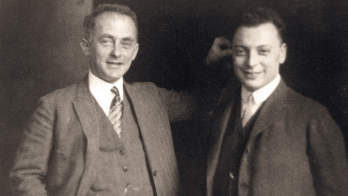Fifty years ago, the discovery of the J/ψ and its excitations sparked the November Revolution in particle physics, giving fresh experimental impetus to the theoretical ideas that would become the Standard Model. Here, we reproduce in full the Courier’s report from December 1974, describing the excitement and confusion that surrounded the new particles and their interpretation. The J/ψ is now known to be a bound state of a charm quark and a charm antiquark – entities for which there was only indirect evidence at the time of the discoveries.

Anyone in touch with the world of high-energy physics will be well aware of the ferment created by the news from Brookhaven and Stanford, followed by Frascati and DESY, of the existence of new particles. But new particles have been unearthed in profusion by high-energy accelerators during the past 20 years. Why the excitement over the new discoveries?
A brief answer is that the particles have been found in a mass region where they were completely unexpected with stability properties which, at this stage of the game, are completely inexplicable. In this article we will first describe the discoveries and then discuss some of the speculations as to what the discoveries might mean.
We begin at the Brookhaven National Laboratory where, since the Spring of this year, a MIT/Brookhaven team have been looking at collisions between two protons which yielded (amongst other things) an electron and a positron. A series of experiments on the production of electron–positron pairs in particle collisions has been going on for about eight years in groups led by Sam Ting, mainly at the DESY synchrotron in Hamburg. The aim is to study some of the electromagnetic features of particles where energy is manifest in the form of a photon which materialises in an electron–positron pair. The experiments are not easy to do because the probability that the collisions will yield such a pair is very low. The detection system has to be capable of picking out an event from a million or more other types of event.
Beryllium bombardment
It was with long experience of such problems behind them that the MIT/Brookhaven team led by Ting, J J Aubert, U J Becker and P J Biggs brought into action a detection system with a double arm spectrometer in a slow ejected proton beam at the Brookhaven 33 GeV synchrotron. They used beams of 28.5 GeV bombarding a beryllium target. The two spectrometer arms span out at 15° either side of the incident beam direction and have magnets, Cherenkov counters, multiwire proportional chambers, scintillation counters and lead glass counters. With this array, it is possible to identify electrons and positrons coming from the same source and to measure their energy.
From about August, the realisation that they were on to something important began slowly to grow. The spectrometer was totting up an unusually large number of events where the combined energies of the electron and positron were equal to 3.1 GeV.

This is the classic way of spotting a resonance. An unstable particle, which breaks up too quickly to be seen itself, is identified by adding up the energies of more stable particles which emerge from its decay. Looking at many interactions, if energies repeatedly add up to the same figure (as opposed to the other possible figures all around it), they indicate that the measured particles are coming from the break up of an unseen particle whose mass is equal to the measured sum.
The team went through extraordinary contortions to check their apparatus to be sure that nothing was biasing their results. The particle decaying into the electron and positron they were measuring was a difficult one to swallow. The energy region had been scoured before, even if not so thoroughly, without anything being seen. Also the resonance was looking “narrow” – this means that the energy sums were coming out at 3.1 GeV with great precision rather than, for example, spanning from 2.9 to 3.3 GeV. The width is a measure of the stability of the particle (from Heisenberg’s Uncertainty Principle, which requires only that the product of the average lifetime and the width be a constant). A narrow width means that the particle lives a long time. No other particle of such a heavy mass (over three times the mass of the proton) has anything like that stability.
By the end of October, the team had about 500 events from a 3.1 GeV particle. They were keen to extend their search to the maximum mass their detection system could pin down (about 5.5 GeV) but were prodded into print mid-November by dramatic news from the other coast of America. They baptised the particle J, which is a letter close to the Chinese symbol for “ting”. From then on, the experiment has had top priority. Sam Ting said that the Director of the Laboratory, George Vineyard, asked him how much time on the machine he would need – which is not the way such conversations usually go.
The apparition of the particle at the Stanford Linear Accelerator Center on 10 November was nothing short of shattering. Burt Richter described it as “the most exciting and frantic week-end in particle physics I have ever been through”. It followed an upgrading of the electron–positron storage ring SPEAR during the late Summer.
Until June, SPEAR was operating with beams of energy up to 2.5 GeV so that the total energy in the collision was up to a peak of 5 GeV. The ring was shut down during the late summer to install a new RF system and new power supplies so as to reach about 4.5 GeV per beam. It was switched on again in September and within two days beams were orbiting the storage ring again. Only three of the four new RF cavities were in action so the beams could only be taken to 3.8 GeV. Within two weeks the luminosity had climbed to 5 × 1030 cm–2 s–1 (the luminosity dictates the number of interactions the physicists can see) and time began to be allocated to experimental teams to bring their detection systems into trim.
It was the Berkeley/Stanford team led by Richter, M Perl, W Chinowsky, G Goldhaber and G H Trilling who went into action during the week-end 9–10 November to check back on some “funny” readings they had seen in June. They were using a detection system consisting of a large solenoid magnet, wire chambers, scintillation counters and shower counters, almost completely surrounding one of the two intersection regions where the electrons and positrons are brought into head-on collision.
Put through its paces
During the first series of measurements with SPEAR, when it went through its energy paces, the cross-section (or probability of an interaction between an electron and positron occurring) was a little high at 1.6 GeV beam energy (3.2 GeV collision energy) compared with at the neighbouring beam energies. The June exercise, which gave the funny readings, was a look over this energy region again. Cross-sections were measured with electrons and positrons at 1.5, 1.55, 1.6 and 1.65 GeV. Again 1.6 GeV was a little high but 1.55 GeV was even more peculiar. In eight runs, six measurements agreed with the 1.5 GeV data while two were higher (one of them five-times higher). So, obviously, a gremlin had crept in to the apparatus. While meditating during the transformation from SPEAR I to SPEAR II, the gremlin was looked for but not found. It was then that the suspicion grew that between 3.1 and 3.2 GeV collision energies could lie a resonance.
During the night of 9–10 November the hunt began, changing the beam energies in 0.5 MeV steps. By 11.00 a.m. Sunday morning the new particle had been unequivocally found. A set of cross-section measurements around 3.1 GeV showed that the probability of interaction jumped by a factor of 10 from 20 to 200 nanobarns. In a state of euphoria, the champagne was cracked open and the team began celebrating an important discovery. Gerson Goldhaber retired in search of peace and quiet to write the findings for immediate publication.

While he was away, it was decided to polish up the data by going slowly over the resonance again. The beams were nudged from 1.55 to 1.57 and everything went crazy. The interaction probability soared higher; from around 20 nanobarns the cross-section jumped to 2000 nanobarns and the detector was flooded with events producing hadrons. Pief Panofsky, the Director of SLAC, arrived and paced around invoking the Deity in utter amazement at what was being seen. Gerson Goldhaber then emerged with his paper proudly announcing the 200 nanobarn resonance and had to start again, writing 10 times more proudly.
Within hours of the SPEAR measurements, the telephone wires across the Atlantic were humming as information enquiries and rumours were exchanged. As soon as it became clear what had happened, the European Laboratories looked to see how they could contribute to the excitement. The obvious candidates, to be in on the act quickly, were the electron–positron storage rings at Frascati and DESY.
From 13 November, the experimental teams on the ADONE storage ring (from Frascati and the INFN sections of the universities of Naples, Padua, Pisa and Rome) began to search in the same energy region. They have detection systems for three experiments known as gamma–gamma (wide solid angle detector with high efficiency for detecting neutral particles), MEA (solenoidal magnetic spectrometer with wide gap spark chambers and shower detectors) and baryon–antibaryon (coaxial hodoscopes of scintillators covering a wide solid angle). The ADONE operators were able to jack the beam energy up a little above its normal peak of 1.5 GeV and on 15 November the new particle was seen in all three detection systems. The data confirmed the mass and the high stability. The experiments are continuing using the complementary abilities of the detectors to gather as much information as possible on the nature of the particle.
At DESY, the DORIS storage ring was brought into action with the PLUTO and DASP detection systems described later in this issue on page 427. During the week-end of 23–24 November, a clear signal at about 3.1 GeV total energy was seen in both detectors, with PLUTO measuring events with many emerging hadrons and DASP measuring two emerging particles. The angular distribution of elastic electron–positron scattering was measured at 3.1 GeV, and around it, and a distinct change was seen. The detectors are now concentrating on measuring branching ratios – the relative rate at which the particle decays in different ways.
Excitation times
In the meantime, SPEAR II had struck again. On 21 November, another particle was seen at 3.7 GeV. Like the first it is a very narrow resonance indicating the same high stability. The Berkeley/Stanford team have called the particles psi (3105) and psi (3695).
No-one had written the recipe for these particles and that is part of what all the excitement is about. At this stage, we can only speculate about what they might mean. First of all, for the past year, something has been expected in the hadron–lepton relationship. The leptons are particles, like the electron, which we believe do not feel the strong force. Their interactions, such as are initiated in an electron–positron storage ring, can produce hadrons (or strong force particles) via their common electromagnetic features. On the basis of the theory that hadrons are built up of quarks (a theory that has a growing weight of experimental support – see CERN Courier October 1974 pp331–333), it is possible to calculate relative rates at which the electron–positron interaction will yield hadrons and the rate should decrease as the energy goes higher. The results from the Cambridge bypass and SPEAR about a year ago showed hadrons being produced much more profusely than these predictions.
What seems to be the inverse of this observation is seen at the CERN Intersecting Storage Rings and the 400 GeV synchrotron at the FermiLab. In interactions between hadrons, such as proton–proton collisions, leptons are seen coming off at much higher relative rates than could be predicted. Are the new particles behind this hadron–lepton mystery? And if so, how?

Other speculations are that the particles have new properties to add to the familiar ones like charge, spin, parity… As the complexity of particle behaviour has been uncovered, names have had to be selected to describe different aspects. These names are linked, in the mathematical description of what is going on, to quantum numbers. When particles interact, the quantum numbers are generally conserved – the properties of the particles going into the interaction are carried away, in some perhaps very different combination, by the particles which emerge. If there are new properties, they also will influence what interactions can take place.
To explain what might be happening, we can consider the property called “strangeness”. This was assigned to particles like the neutral kaon and lambda to explain why they were always produced in pairs – the strangeness quantum number is then conserved, the kaon carrying +1, the lambda carrying –1. It is because the kaon has strangeness that it is a very stable particle. It will not readily break up into other particles which do not have this property.
They baptised the particle J, which is a letter close to the Chinese symbol for “ting”
Two new properties have recently been invoked by the theorists – colour and charm. Colour is a suggested property of quarks which makes sense of the statistics used to calculate the consequences of their existence. This gives us nine basic quarks – three coloured varieties of each of the three familiar ones. Charm is a suggested property which makes sense of some observations concerning neutral current interactions (discussed below).
It is the remarkable stability of the new particles which makes it so attractive to invoke colour or charm. From the measured width of the resonances they seem to live for about 10–20 seconds and do not decay rapidly like all the other resonances in their mass range. Perhaps they carry a new quantum number?
Unfortunately, even if the new particles are coloured, since they are formed electromagnetically they should be able to decay the same way and the sums do not give their high stability. In addition, the sums say that there is not enough energy around for them to be built up of charmed constituents. The answer may lie in new properties but not in a way that we can easily calculate.
Yet another possibility is that we are, at last, seeing the intermediate boson. This particle was proposed many years ago as an intermediary of the weak force. Just as the strong force is communicated between hadrons by passing mesons around and the electromagnetic force is communicated between charged particles by passing photons around, it is thought that the weak force could also act via the exchange of a particle rather than “at a point”.
Perhaps the new particles carry a new quantum number?
When it was believed that the weak interactions always involved a change of electric charge between the lepton going into the interaction and the lepton going out, the intermediate boson (often referred to as the W particle) was always envisaged as a charged particle. The CERN discovery of neutral currents in 1973 revealed that a charge change between the leptons need not take place; there could also be a neutral version of the intermediate boson (often referred to as the Z particle). The Z particle can also be treated in the theory which has had encouraging success in uniting the interpretations of the weak and electromagnetic forces.
This work has taken the Z mass into the 70 GeV region and its appearance around 3 GeV would damage some of the beautiful features of the reunification theories. A strong clue could come from looking for asymmetries in the decays of the new particles because, if they are of the Z variety, parity violation should occur.
1974 has been one of the most fascinating years ever experienced in high-energy physics. Still reeling from the neutral current discovery, the year began with the SPEAR hadron production mystery, continued with new high-energy information from the FermiLab and the CERN ISR, including the high lepton production rate, and finished with the discovery of the new particles. And all this against a background of feverish theoretical activity trying to keep pace with what the new accelerators and storage rings have been uncovering.
- For further details and an account of current challenges and opportunities in charm physics, see “Charming clues for existence”.








